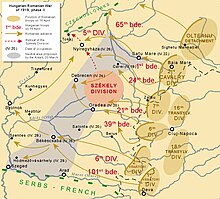Marcel Olteanu
Marcel Olteanu | |
|---|---|
Order of the Crown, Commander rank Order of Michael the Brave, 3rd Class | |
| Alma mater | Higher War School |
| Children | Marcel M. Olteanu (son) |
| Relations | Adelina Olteanu (sister) |
Marcel Olteanu (May 4, 1872 – 1943) was a Romanian brigadier general during World War I and the Hungarian–Romanian War.
He was born in
Order of the Crown, Officer rank. He completed his studies at the Higher War School in Bucharest. Olteanu served in the Second Balkan War in 1913, and was decorated with the Avântul Țării Medal.[5] He was promoted to lieutenant colonel in April 1914 and colonel in May 1916. Starting in October 1912, Olteanu was the inaugural commandant of the "Nicolae Filipescu" Military School at Dealu Monastery; he served in this position until August 1918.[6]
After
German forces.[7] (His son, Marcel M. Olteanu, a graduate of the Dealu Monastery military school, also fought in this battle.[6]) For his valor Olteanu was awarded in September 1920 the Order of Michael the Brave, 3rd class.[8] In early December 1917, he was put in charge of the central command of the Romanian Volunteer Corps in Russia, based in Hârlău, Iași County.[9][10][4]


In 1918, Olteanu was given command of the 6th Infantry Division. The next year he fought in the
In late July the Romanian Army crossed the Tisza River and advanced towards Budapest, leading to the collapse of the Hungarian Soviet Republic. From August to November 1919, Olteanu served as military governor of Budapest.[12]After the war, Olteanu retired from the army, and was put in reserve with the First Army Corps. He died in Bucharest in 1943. A street in Cilieni, Olt County now bears his name.
Publications
- Deprinderi tactice pentru tinerii ofițeri din toate armele [Tactical skills for young officers in all weapons] (in Romanian). București: Institutul Grafic Universala, Iancu Ionescu. 1910.
- Huzarul negru. Carte ostășească, ostașilor români [The black hussar. Military book for the Romanian soldiers] (in Romanian) (2nd ed.). București: Editura Institutul de Arte Grafice Răsăritul. 1926 [1915].
References
- ^ Țuțu, D. (1968), "Voluntarii români din Transilvania în lupta împotriva Puterilor Centrale, pentru eliberare națională și unitate (1916–1918)", Studii – Revistă de Istorie (in Romanian), 21 (6): 1125–1144
- ^ Uszkai, Nicolae (9 June 2019). "Roata istoriei. Contribuția voluntarilor români la mișcarea de eliberare națională, II". jurnalspiritual.eu (in Romanian). Retrieved December 20, 2020.
- ^ Spânu, Alin (2012), "Serviciul de informații politice și propagandă și analiza situației din Banat (începutul anului 1919)" (PDF), Buletinul Arhivelor Militare Române (in Romanian), 15 (3): 46–48, retrieved December 20, 2020
- ^ a b "Voluntari ardeleni și bucovineni în armata română în Primul Război Mondial". www.istorie-pe-scurt.ro (in Romanian). February 12, 2014. Retrieved December 20, 2020.
- ^ Ministerul de Răsboiu, Anuarul Armatei Române pe anul 1916, Tipografia "Universala" Iancu Ionescu, București, 1916
- ^ a b Staicu-Buciumeni, Neculai I. (2006). "Colegiul Național "Nicolae Filipescu"" (PDF) (in Romanian). Retrieved December 16, 2020.
- ^ "Colonelul descălecător" [The dismounted colonel]. Cațavencii (in Romanian). October 11, 2019. Retrieved December 20, 2020.
- ^ Ministerul de Răsboiu, Anuarul ofițerilor și drapelelor Armatei Române cărora li s-au conferit ordinul "Mihai Viteazul", Atelierele grafice "Socec & Co", București, 1930, p. 110
- 1 December University of Alba Iulia: 101–111. Archived from the original(PDF) on 2012-04-25.
- ^ Părean, Ioan (2002), "Soldați ai României Mari. Din prizonieratul rusesc în Corpul Voluntarilor transilvăneni și bucovineni (1916 – 1918)" [Soldiers of Greater Romania. From Russian Captivity to the Corps of Transylvanian and Bukovinian Volunteers (1916 – 1918)")] (PDF), Revista Academiei Forțelor Terestre (in Romanian), 3–4, Nicolae Bălcescu Land Forces Academy
- ProQuest 1756230445
- ^ Pena, Cătălin (January 15, 2020). "Toată povestea opincii de pe parlamentul Ungariei, spusă de generalul Olteanu, guvernatorul militar al Budapestei" [The whole story of the opincă on the Hungarian Parliament, told by General Olteanu, the military governor of Budapest]. Evenimentul Istoric (in Romanian). Retrieved December 20, 2020.
